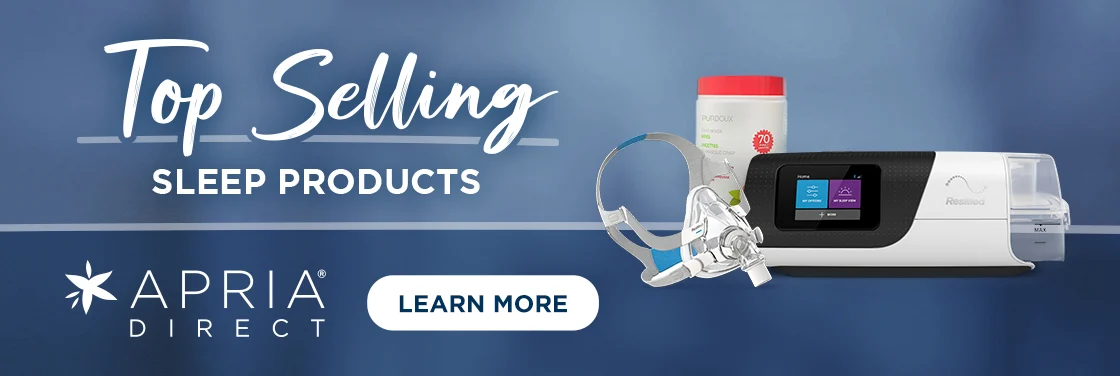ASK APRIA
Today's Clinician

Lesley Williams
Lesley has been a respiratory therapist for 35 years. In her current role here at Apria, she helps train clinical staff with new equipment and supports clinical program initiatives in the southeastern United States. In her free time you can find Lesley spending time with her kids and grandkids, or out enjoying the sun on her boat.
CPAP
Q. I have been using my CPAP machine but I wake up with really bad dry mouth every morning, what should I do?
A. Having a dry mouth is very common with any kind of PAP therapy, especially during the first few weeks to months. Most patients will eventually learn to keep their mouth closed during sleep which will eliminate the dry mouth in most cases. If not, one of the first things we would look at is the type of mask you are using. If it is a full-face mask, adjusting the heated humidity setting will sometimes help to eliminate a dry mouth. If you have a nasal mask or nasal pillows, we may need to add a chin strap to help “train” you to keep your mouth closed at night. The good news is, this is temporary and sporadic for most patients until they become accustomed to the therapy.
For more information: 5 Tips for Preventing CPAP Dry Mouth
Q. Where should your CPAP machine be placed in relation to your face? Should it be higher or lower than your face, or does it matter?
A. The best placement for your CPAP is on a sturdy surface level or lower than the head of your bed. If the CPAP is above your head it can be a potential hazard since you may unintentionally pull it down on your head during your sleep and water can accumulate in the tubing if it is directed down toward your mask. By having it lower or level with your head, both unpleasant experiences can be avoided.
Q. I purchased a new machine and now my events per hour have doubled, what would cause something like that? Can you explain the events per hour? What is good?
A. We define an ‘event’ as an interruption of the normal breathing pattern. Events can be apneas (your breathing stopped for a period), hypopneas (slow shallow breaths) or a combination of the two. Events must be at least 10 seconds in length to be recorded. The number of these events that are recordable make your Events per Hour or Apnea-Hypopnea Index (AHI). Five events per hour is considered normal. Seeing an increase in events with a new machine could be attributed to newer technology and the machine’s sensitivity to recordable events. It could also be that your sleep apnea has worsened and adjustments in your therapy are needed. Make sure to contact your doctor and discuss your concern. Apria will download the information from your machine and give your doctor a more in-depth look at why this may be occurring.
Q. I'm not receiving any data from my Resmed myAir app, how do I fix it?
A. Ultimately Resmed is who would be able to provide the best support for their product, but understandably you want answers! There are a few troubleshooting steps you can go through to help fix this. Resmed has provided the following tips to follow, you can also visit Resmed.com for more information:
1. Did you just register on the same day you tried to view your data? Your therapy data will be available after your first night using the machine following your registration date.
2. Verify that your machine’s power cord is plugged in.
3. Check the machine’s signal strength icon, and verify it has a strong wireless signal (3-5 green bars). A signal strength of less than 3 bars may not be strong enough to transmit your therapy data. If the No Wireless Connection icon displays (a circle over the signal strength bars), your machine cannot detect any wireless networks. You may need to move the machine to a different location to obtain a better signal. Your machine requires a cellular wireless network to transmit therapy data.
4. Verify that your machine is not set to Airplane mode (on the Home screen, select My Options and scroll down to Airplane Mode). If it is, turn Airplane mode off on your machine.
5. Is this the same machine you defined in myAir when you created your account? If not, you will need to change the serial and device numbers in your My Account details on the myAir site.
6. Ensure your machine remains powered on for at least an hour after you wake up.
7. If your machine’s power cord has been continually plugged in, unplug it for 40 seconds and then plug it back in. This resets the machine.
8. Please use your machine as normal, and check myAir the next day to confirm your data transmitted as expected.
If, after performing the steps above and using your machine for one night, you still do not receive therapy data in myAir, please contact Resmed.
Do you have a question for our Respiratory Therapists to be answered in a future email?
We want to hear from you!


